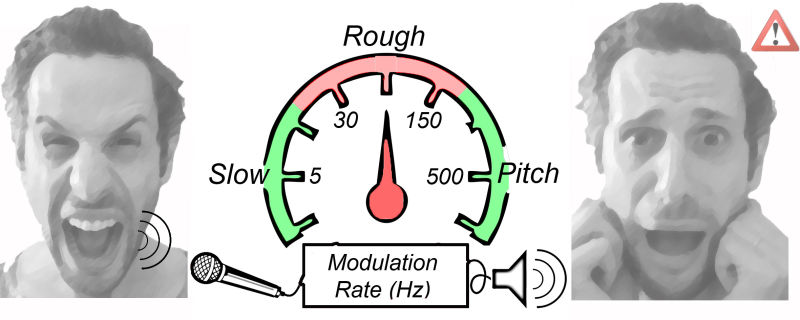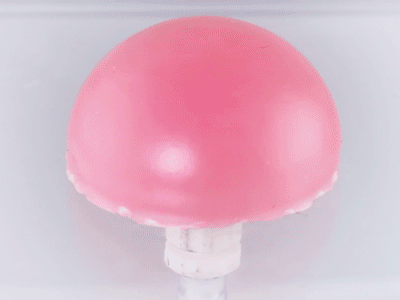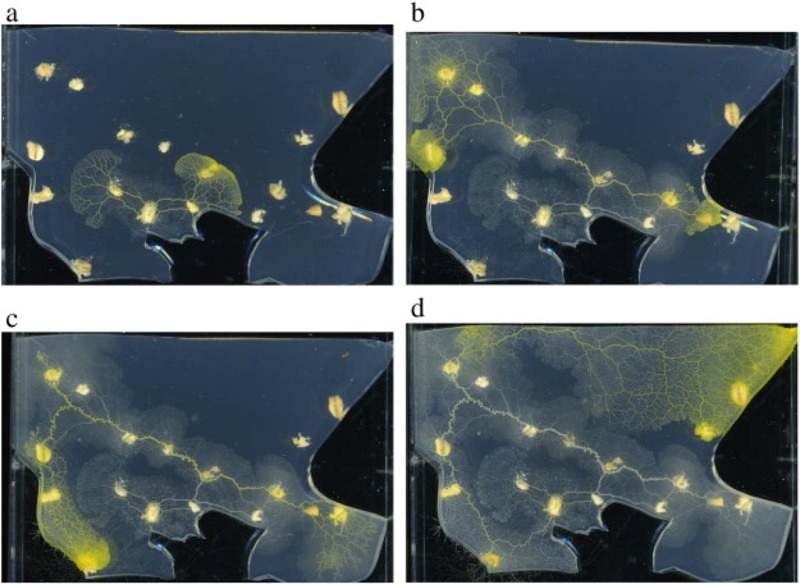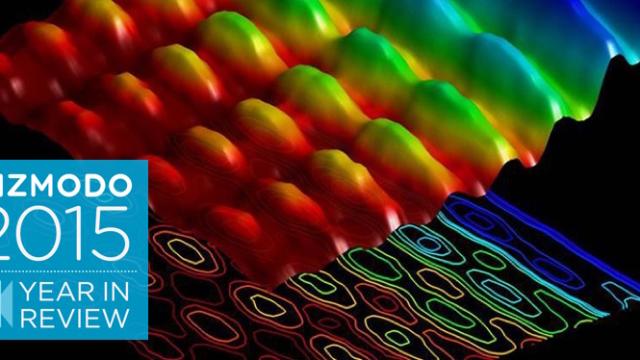Not every scientific advance is heralded as a revolutionary breakthrough, because science mostly progresses in incrementally. Sure, certain high-profile stories caught the lion’s share of attention this year. But there’s still plenty of nifty research going on that deserves a nod of appreciation too. Here are ten of our favourite cool science stories that you may have missed in 2015.
Is This the First Image of Light as Both Particle and Wave?
Early in the year, the first ever photograph of light as a particle and a wave at the same time went viral — but we soon learned the truth was a bit more nuanced than that. Created by a research team led by Fabrizio Carbone at EPFL, the experiment added a twist to the classic photoelectric effect, which explains why, for, instance, UV light hitting a metal target emits electrons. To wit: light exhibits both particle- and wave-like behaviour.
This seemed positively revolutionary, since a cornerstone of quantum mechanics is that you just can’t see both particle and wave aspects at the same time. As Ben Stein explained at Inside Science News, the image is actually lots of photons (the elementary particles of light) imaged together, with some acting like particles and others acting like waves. It’s not the same photons exhibiting their dual nature simultaneously. Maybe it wasn’t as earth-shattering a breakthrough as the Internet originally thought, but it’s still a pretty darn cool picture. [Paper]

Credit: Luc Arnal
The Science of Screaming
Everybody finds the sound of a human scream shrill and jarring. A study by neuroscientists at New York University suggested this might have something to do with how the acoustic quality of a human scream triggers the brain’s fear response. The key is a property of sound known as roughness that refers to how fast a sound changes in loudness. Per co-author Luc Arnal, normal speech has very slow differences in loudness (between 5 and 5 Hz) while screams show faster differences in loudness (between 30 and 150 Hz). He likens the effect to a strobe light, only for sound instead of sight.
Arnal and his then-advisor, NYU neuroscientist David Poeppel, used recordings from YouTube videos, films and screaming volunteers, with varying degrees of roughness, to study how subjects in an fMRI scanner responded. The rougher the sound, the more participants rated it scary or distressing — and the stronger the activation response in the amygdala (often dubbed the fear center of the brain), rather than the auditory cortex. This suggests that our response to roughness in the sounds we hear triggers fear responses, perhaps to help us better react to perceived danger. They also found similar responses to the shrill sounds of crying babies or car alarms. [Paper]
A Quantum “Weeping Angel” Effect
We all know that quantum mechanics is weird. Case in point: a mere act of observation determines the outcome of an experiment. But if we never look away, time effectively stands still. It’s known as the quantum Zeno effect, although a rough analogy can be drawn to the Weeping Angels in Doctor Who. A watched quantum pot never boils. And a watched Weeping Angel can’t move.
There have been a series of experiments confirming that the quantum Zeno effect really happens. (There’s also an “Anti-Zeno Effect,” whereby staring at the metaphorical quantum pot brings it to a boil more quickly — also experimentally confirmed.) Most recently, Cornell University physicists used lasers to trap a gas of rubidium chilled to super-cold temperatures in a lattice of light. Thanks to the peculiarities of quantum mechanics, every now and then, an atom manages to tunnel out of the trap.
But when they repeatedly zapped the atoms with laser pulses at shorter and shorter intervals — the equivalent of looking inside Schroedinger’s proverbial box again and again and again — they found this makes it more difficult for trapped atoms to tunnel out. When the intervals become short enough, the atoms make like a Weeping Angel and are effectively frozen in place. [Paper]
Dance of the Liquid Droplets
Water droplets spread out when they hit a glass surface, but Stanford University scientists were puzzled by the strange behaviour of water droplets dyed with food colouring that also contained propylene glycol (PG). As Gizmodo’s Maddie Stone wrote, “When two droplets of the same PG concentration are placed near one another, they coalesce. However, when droplets of different concentrations are neighbours, they get close but never join. Sometimes they even chase one another.”
In a paper published in Nature, the Stanford scientists described the “beautiful” science that explains why liquid droplets dance with each other in such strikingly synchronised motion. It’s because the dancing drops are “binary,” i.e., contain two different types of fluid. Water evaporates more quickly than PG, and also has a higher surface tension, so it leaves more of the chemical behind as it evaporates away from the droplet’s edge. Then the surface tension kicks in, driving an inward flow. Co-author Manu Prakash likened the effect to a tornado inside the droplet. “Now the engine is running like a car, but the clutch is not engaged,” he told the Washington Post. “The drop doesn’t know where to go.”
When another drop is added, the evaporation from the first acts as a kind of signal, telling the second where to go. The result is that two droplets appear to dance together. The Stanford team even created a guide so you, too, can create dancing droplets at home: you just need food colouring, water, and a glass slide. [Paper]
Earthly Cities Grow Like Galaxies
One of the nifty things about a good mathematical model is that it can reveal hidden connections between two systems that, on the surface, appear to be very different from each other. Two cosmologists, Henry Lin and Abraham Loeb, uncovered just such a surprising correlation, demonstrating that the way galaxies evolve from variations in matter density in the early universe is mathematically equivalent to the way cities grow from changes in population density on Earth.
Their analysis centres on a well-known scaling pattern known as Zipf’s law, observed in everything from personal friendships to the population density of cities. As Gizmodo’s Kelsey Campbell-Dollaghan wrote, “Basically, the city with the highest population in a country will be twice as large as the next most populous city, and three times as large as the third most populous city, and so on.” The same holds true for galaxies, it seems. Loeb and Lin took a mathematical formula describing how galaxies form and evolve and applied it to the evolution of cities on Earth. The two systems proved remarkably similar. The scientists think that similar mathematical tools could be used to better model the spread of epidemics, among other applications. [Paper]
A Grand Theory of Wrinkles

Credit: Denis Terwagne and Pedro Reis, MIT
Wrinkles are found all throughout nature, from the surfaces of planets, to the dimples on a golf ball, and even in the small intestine. But these systems are usually studied on a case-by-case basis, working backwards to create computer simulations to better understand how and why they form. This year a team of engineers and mathematicians at MIT came up with their own grand unified theory of wrinkles, especially applicable to wrinkles that form on curved surfaces.
MIT engineer Pedro Reis has spent years studying how objects wrinkle. While conducting experiments on silicone test spheres, he noted that when he sucked the air out, some of those spheres formed dimples under pressure, but others formed a more squiggly pattern. His MIT colleague, mathematician Jorn Dunkel, noted a similarity between the latter and the patterns that appear when one heats a thin layer of oil. The two departments combined their efforts, pouring over all of Reis’ experimental data.
They found that the kind of patterns that formed depended on just two factors: the curvature of the lower layer in relation to the thickness of the top wrinkling layer, and how much stress was applied to the wrinkling layer. “Our theory you could basically apply to the surface of the moon or Mars, or the surface of a grape,” co-author Norbert Stroop told Quanta magazine. [Paper]
Getting to the Bottom of the Lollipop Hypothesis
It’s a question that featured in a classic candy commercial: how many licks does it take to get to to center of a Tootsie-Pop? This year we learned the answer: about 2500, according to experiments by physicists at New York University. Call it the Lollipop Hypothesis. The NYU researchers used the candy to determine how fluids dissolve solids, a topic that also applies to the erosion of rivers and how pills dissolve in the body.
The NYU team made their own homemade lollipops out of boiled sugar, corn syrup, and water, which they then moulded into various shapes. Then they immersed the lollipops in a “water tunnel” (the aquatic equivalent of a wind tunnel) and watched them dissolve, varying the flow speed of the water. They found that there seems to be a preferred shape that objects take on as they dissolve, per Physics Buzz: “a smooth rounded front, a beveled facet in the middle, and a flat back side.” They also found that the dissolve rate depends on flow speed: for example, change the speed from 2km/h to 6km/h and the lollipop would completely dissolve in half the time.
As for counting the number of licks, they calculated it would take an estimated 1000 swipes of the tongue per centimeter of candy to reach the center of a Tootsie-Pop. Since the candy measures about 1.063 in diameter, that translates into 2500 licks. [Paper]
Solving the Mystery of How Glass Forms
Glass is a class of materials that has been around for a very long time, yet its deeper secrets still elude physicists — particularly the stubborn mystery of how glass forms at the molecular level. A team of Canadian and French scientists devised a new model for how a liquid turns into a glass by combining, for the first time, two decades-old theories: crowding and cooperative movement.
Molecular crowding basically treats molecules within glasses as people moving about a crowded room. The key element is density. As more and more people squeeze into the room, there is less space, so people (or molecules) move more slowly — although those located near the door are still able to move more freely, just like the molecules on a glassy surface never stop flowing, even at lower temperatures.
That’s where cooperative movement kicks in. As the crowd thickens, people tend to move in conjunction with their nearest neighbours. The scientists found that molecules exhibit similar behaviour, forming strings of weak molecular bonds with their nearest neighbours. The new model could prove useful for developing novel glassy nano materials with useful properties. [Paper]

Credit: Evangelidis, V. et al./Journal of Archaeological Science
Slime Mould Builds an Ancient Road Network
Take a moment to marvel at the humble slime mould, an ancient group of organisms that reproduce via spores and get their name from the dimly stuff they excrete. When times get tough, slime molds band together, and exhibit a strange kind of hive-mind, or cooperative intelligence. They can solve mazes, change their appearance, and find the most efficient path between two food sources. And this year they helped reconstruct an ancient road network.
Greek archaeologists used a bright yellow slime mould called Physarum polycephalum to, in essence, redraw the ancient Roman road networks running through the Balkans between the 1st and 4th centuries A.D. They grew the molds on a map of the area made up of agar gel, with oat flakes at strategic locations, representing major Roman cities. The slime molds reproduced the network accurately. Those roads were well known from historical documents; this experiment was proof of principle. The archaeologists hope that they can use slime molds to help reconstruct lesser-known pathways that have been lost. So the best archaeological assistants of the 21st may well be be slime molds. [Paper]

Prat-Camps, J. et al./Scientific Reports
A Magnetic Wormhole Illusion
A team of scientists at Autonomous University of Barcelona, Spain took materials science into stealth mode, creating a “wormhole illusion” that causes magnetic field to move through space undetected. The operative word here is “illusion.” This is not a bona fide wormhole connecting two points in space-time — a staple of science fiction decades, although we’ve never observed any directly. Rather, it’s created using metamaterials to tunnel magnetic fields from one point to another
The device is made of two concentric spheres encasing a spiral of ferromagnetic metal. As Gizmodo’s Maddie Stone wrote,
The ferromagnet transmits magnetic field lines from one end of the device to the other. Meanwhile, a shell of yttrium barium copper oxide (a superconducting material, yellow) bends and distorts the magnetic field lines as they travel. An outer shell composed of “mu-metals” (used for shielding electronic devices, silver) perfectly cancels out the magnetic distortion of the superconductor, rendering the entire thing “magnetically invisible” from the outside. Dunk it all in a liquid nitrogen bath — superconductors only work at extremely low temperatures — and voila, you’ve got yourself a wormhole.
It’s a very cool experiment, with a purpose: it could one day help improve medical scanners. Per New Scientist: “Wormholes could let multiple magnetic imagers work together without interfering with each other, or could be used to put some distance between bulky sensors and patients — all without changing the background magnetic field MRIs rely on.” [Paper]
Top image: Fabrizio Carbone/EPFL.
